Knife sharpening is an essential skill for anyone who uses knives regularly. There are different methods and tools you can use to sharpen your knife effectively. In this section, we will explore two popular methods: using a traditional sharpening stone and the sandpaper method. We’ll provide step-by-step instructions and tips to help you keep your knives sharp and ready for any cutting task.
When it comes to sharpening your knife, having the right tools is crucial. Using the right equipment can make the sharpening process easier and more efficient. In the traditional sharpening stone method, you’ll need a sharpening stone of your choice. Alternatively, the sandpaper method requires wet/dry sandpaper in various grit sizes and a mousepad for stability.
Whether you prefer the traditional or sandpaper method, both techniques can help you achieve a sharp and functional knife. So, let’s dive in and find out how to sharpen your knife using these methods!
How to Sharpen a Knife with a Traditional Sharpening Stone
Sharpening a knife with a traditional sharpening stone is a skill that everyone should know. By following a few simple steps, you can bring back the sharpness to your dull knife.
- Choose the Right Sharpening Stone: Begin by selecting a sharpening stone that suits your needs. There are various types of stones available, such as water stones and oil stones. Make sure to use water or a light mineral oil as a lubricant to prevent heat buildup and ensure smooth sharpening.
- Color the Knife Bevel: To ensure accurate sharpening, color the sharpening bevel of your knife with a permanent marker. This will help you identify the areas where the stone is making contact with the edge.
- Find the Perfect Angle: The next step is to find the right angle for sharpening your knife. This angle will vary depending on the type of knife and its intended use. Hold the knife close to the blade and maintain a consistent angle throughout the sharpening process.
- Raise a Burr: Start by making light passes on the stone, moving the knife from the tip towards the heel. This process will help raise a burr on one side of the blade. Once you achieve a burr, repeat the process on the other side of the blade.
- Refine the Edge: After raising a burr on both sides, refine the edge by making alternating passes on the sharpening stone. Apply consistent pressure and maintain the angle you’ve chosen. You can use an angle guide for additional guidance and consistency.
- Test Sharpness: To ensure the effectiveness of the sharpening process, test the sharpness of the knife by slicing a piece of paper. A well-sharpened knife should cut through the paper effortlessly.
Practice and patience are key to mastering the art of sharpening a knife with a traditional sharpening stone. With time, you will be able to refine your technique and achieve a razor-sharp edge that is perfect for any cutting task.

| Advantages | Disadvantages |
|---|---|
| Provides control over the sharpening process | Requires practice and skill to master |
| Can be used for various types of knives | May take longer to sharpen compared to other methods |
| Allows for the customization of the sharpening angle | Requires the purchase of a sharpening stone |
How to Sharpen a Knife with the Sandpaper Method
The sandpaper method is a popular alternative for sharpening knives, providing the possibility of achieving a precise, convex edge. To get started, gather wet/dry sandpaper in multiple grit sizes and a mousepad. Attach the sandpaper securely to a flat surface, such as a cutting board or work table, or place it on top of a mousepad to prevent slipping.
Begin by coloring the edge bevel of your knife with a permanent marker. This coloring will help you easily identify the areas where you’ve made contact with the sandpaper. Find the angle that suits your knife best and start grinding the blade against the sandpaper. Remember to apply light pressure and maintain a consistent angle throughout the process.
After raising a burr on one side of the blade, switch to the other side and repeat the process. As you progress, use sandpaper with higher grit sizes to refine the edge. By going up to higher grits, you can achieve a mirror-polished finish and an even sharper edge. Always ensure that you maintain the edge trailing the spine of the blade during this method.
To effectively remove any remaining burrs left from the grinding process, you can opt to stroke the edge using the sandpaper or another substrate. This additional step will help smoothen the blade and achieve a superior level of sharpness. Remember, with practice and precision, you can attain a razor-sharp knife using the sandpaper method.




